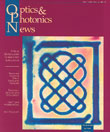
May 1993 Issue
Feature Articles
Microlaser Arrays for Optical Information Processing
Recent Advances in vertical -cavity surface-emitting microlaser arrays opened a variety of new possibilities in the field of optical information processing. This article describes some of the recent progress in compact, robust, and ultrafast optical information processors that can be used for image/signal processing, pattern recognition, and neural networks, as well as holographic storage, optical interconnects, and image transmission.
by Eung Gi PaekWhodunnit? The Case of the Optical Sleuth
Of the 15,000 police departments across the U.S., only major urban centers and federal government crime labs can afford the hefty price tags associated with high tech. Budget crunches force many states such as California to choose between updating forensic labs and supplying patrolmen with flak jackets. "The camel hairbrush and powder, a fingerprint identification technique that preceded Orville and Wilbur Wright, are still the norm," notes Roland Menzel, a forensic researcher at Texas Tech University.
by Susan M. ReissYea or Nay on Optical Fabrication, Coating Standards
Now that the final voting on the acceptance of ISO 10110 and 9211 as international standards is complete, it's time to address the impact on the optical fabrication and coating communities. I do not yet know the outcome of the voting, but every indication is that both standards will be adopted in their entirety after some minor editorial revisions. ISO 10110 deals with how to represent optical elements and their significant features on mechanical drawings. These features include mechanical tolerances, surface figure and finish, and centering requirements, among others. ISO 9211 covers how to represent optical coatings on drawings or specifications, and includes the coating function, spectral response, and durability.
by Robert E. ParksColor Perception Experiments for Children
Experiments in color combinations can be both pretty and interesting to do with a youngster. This short series of experiments leads to a better understanding of color perception and its use in producing TV images. And they can be done at home.
by Janet ShieldsOptical Materials For Excimer Laser Applications
While excimer lasers have been commercially available since the late 1970s, their main use until recently has been as powerful UV photon sources in research and development laboratories. In the R&D environment, large amounts of experimental data can be obtained with few laser pulses (thousands, tens of thousands, and, in rare cases, several millions). The durability of optical components used in these experiments has therefore not been a source of concern. UV-grade lenses, mirrors, and vacuum windows would be incorporated in the experimental setup with the implicit assumption that their optical properties would be invariable over time, as are the properties of visible-grade elements used with, for instance, frequency-doubled pulsed Nd:YAG lasers. Furthermore, not much thought was given to the details of the UV transmission of optical materials. As long as the vendor specified a nominal transmission at the appropriate wavelength (say, 98% excluding surface reflections), the material was frequently deemed adequate for its intended purpose. And indeed it often was.
by M. Rothschild

![Manual probe system with needles for test of semiconductor on silicon wafer. [A. Morozov / Getty]](https://opnmedia.blob.core.windows.net/$web/opn/media/images/articles/2025/1125/departments/202511-cover-web.jpg?ext=.jpg)
![Researcher Clara Saraceno in the lab. [Image by Carsten Behler Photography]](https://opnmedia.blob.core.windows.net/$web/opn/media/images/articles/2025/1025/departments/202510-cover-web.jpg?ext=.jpg)
